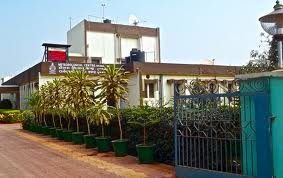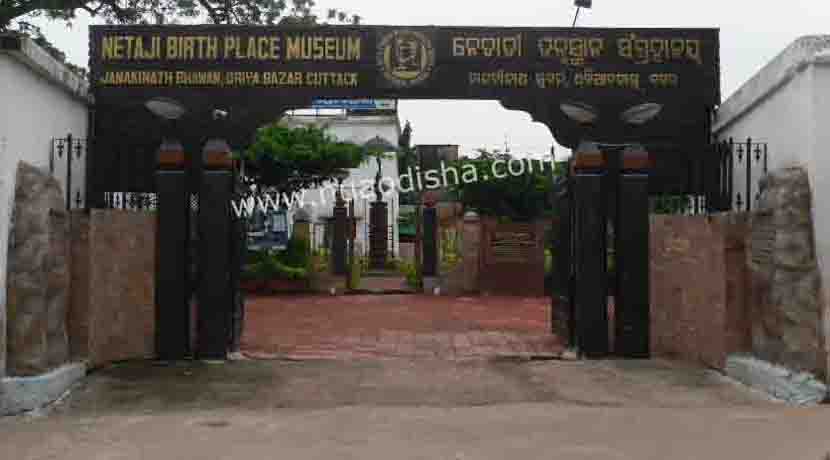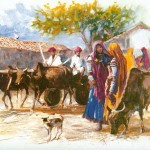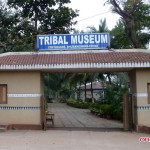
Archeological Museum :
The museum housing the fallen sculptures and architectural members of the Sun temple was shifted to the present museum building in 1968.
The present museum is located little away from the main temple in the north direction.The museum has four galleries displaying
260 various antiquities retrieved from the clearance work of Sun temple. Besides, it has a rich reserve collection.
The first gallery has 62 antiquities many of the sculptures retrieved from the Sun temple complex have been displayed in this gallery.
The image of Surya in sand stone the sculpture in chlorite stone include the king in discussion, marriage scenes,
the various incarnations of Visnu, etc. The Khandolite built reconstructed wheel which has been displayed by collecting the various portions of the wheel.
Besides, other important antiquities have been displayed in the showcases.
The second gallery has 108 antiquities on display. The reconstructed wall of temple, cult objects like dikpals and celestial nymphs,
the head of the crocodile in gigantic nature, the flora and fauna carved on stone, the drummer, etc. are among main display in the gallery.
The third gallery has 45 objects. The huge figures of superb workmanship have been displayed in this gallery include celestial nymphs,
image of Surya Narayana, Gaja-Vyala, the king and his troop. Some erotic figures are also exhibited in this gallery. Many of the images have
also been displayed in the show cases.
The fourth gallery is recently organized and has 45 artifacts on display. The objects include roaring lion, man tied by the elephant trunk,
crocodile head meant for pranala in the temple, part of a Surya image and king witnessing dance performance, erotic couples, salabhanjikas,
elephants on pilaster, scroll works and swans taking the garland etc.
The corridor is utilized by display of images of various ancient monuments and archaeological sites of Orissa displaying evolution and development
of Orissan architecture.
Opening Hours : 10.00 am to 5.00 pm
Closed on – Friday
Entrance Fee :
Rs. 5/- per head
(Children up to 15 years free)

Natural History Museum :
Regional Museum of Natural History, Bhubaneswar, is an Eastern regional centre of the National Museum of Natural History,
under the Ministry of Environment and Forests, Govt. of India, New Delhi.
The goal of the museum is to impart non-formal environmental education to the public in general and the student community in particular in order to
inculcate the awareness about the importance of flora, fauna and subsequent conservation of our natural resources.
Situated in the temple city of Bhubaneswar, Orissa, near Acharya Vihar Square on National Highway 5, this museum is yet another destination and
a meaningful visit for students, adults and family members from all sections of society.
An aesthetically designed building and landscape sets the tone for an informal and joyful learning experience about our natural heritage and the
importance of its conservation. It offers an exciting opportunity for hands on and minds on activity to interact with the exhibits under recreated
environment to attain the knowledge about the harmony of plants and animals and their interrelationships in nature.
The museum attempts to showcase the vibrant biodiversity of Orissa, the NorthEast and the Andaman and Nicobar Islands depicting their richness under
one roof thereby making people aware of the natural heritage of the state and beyond. Extending the excellent facilities to the masses in order to make
environmental education to the common man is the driving force behind the creation of the museum. It attempts to strike a chord with the common man and
appraise him of the importance of the natural bio resources and their conservation. After all, the survival of the common man is dependent of the
conservation of our natural heritage.

Netaji Birth Place :
The name of Netajee Subhash Chandra Bose fills every Indian with pride and with emotions of patriotism. Everyone acknowledges that he was
a great leader, who changed the course of history of India.In the struggle of India’s Independence against the British, his Contribution
has been unique. He sacrificed his everything to attain independence and even today is a source of inspiration to the Indian people.
Janakinath Bhawan, the ancestral house of Netaji Subhas Chandra Bose, is located at Oriya Bazar in Cuttack city of Orissa. Subhas Bose was
born in this house on 23.1.1897 and spent his early childhood at Cuttack. He lived in this house with a large family of eight brothers and six sisters.
His father Janakinath Bose was a lawyer by profession and a man of repute during his time. Subhas Bose passed Entrance examination from Ravenshaw
Collegiate School in 1913 and thereafter went to Calcutta to pursue higher studies.
The house complex consists of an old two storeyed L-shaped building with the main block running from West to East. There is a small temple on the
back of the building on east side. Another row of houses is located close to the eastern boundary wall, which was used as the stable. There used to
be a garden on the north side of the building with an open courtyard on the south of the main building. Each floor has four living rooms. Each floor
had running long verandahs in front of the living rooms with openings on south side. There had been additions and alterations in later times in the
complex.
With financial assistance from the Deptt. of Culture, Govt. of India, the Janakinath Bhawan has been now converted into the Netaji Birth Place Museum
of National standard with change of the present ambience into that of late 19th and early 20th century. The livings rooms have been converted
into galleries displaying the different stages of life and activities of this great personality of our country through photographs. The other
important exhibits in the Museum include old furnitures, house hold articles, documents, books and other objects of use found in the house and
collected from various sources.
A Library is being organized where books published on Netaji in any language and any place are being gradually collected.
Interesting collections in the Museum include 22 original letters written by Netaji from Geneva, Milan in Italy, Shillong,
Mandalay Jail, Rangoon Jail in Myanmar, Presidency Jail, Alipore New Central Jail in Calcutta and Berlin to his parents and family
members. The other exhibits of importance are the old household furnitures, books on Veda, Upanisad, Epics, Jurisprudence and Law.
There is proposal to have an open air auditorium on the South West side of the courtyard along with laying out a formal garden
on the north side of the building so that the place becomes a place of tourist importance and perpetuate the memory of this great
son of soil.

Modern Art Gallery :
Bhubaneshwar, the capital of Orissa, is also commonly known as the “Temple City of India”. It is the home town for the famous
Tribhubaneswar or ‘Lord Lingaraj’, Bhubaneshwar is an important Hindu pilgrimage centre. You shall come across hundreds of temples
which are scattered over the old town. The town once boasted of more than 2000 temples. Besides visiting the exquisite temples of
Bhubaneshwar, explore the Museums and Monuments in Bhubaneshwar which are equally interesting and deserves a visit. Orissa Modern Art
gallery in Bhubaneshwar features some interesting artifacts which are indeed exclusive.
History of Orissa Modern Art gallery Bhubaneshwar
Karen Kent, a US citizen visited Bhubaneshwar and initiated for the opening of Bhubaneshwar Orissa Modern art gallery.
The Orissa Modern Art Gallery at Surya Nagar was founded by Karen Kent and Tarakanta Parida, a famous artist. The gallery now boasts
of the best art works from modern young artists as well as veterans. What makes this gallery even more significant is that it showcases the oils,
acrylic, lithographs, etchings, drawings and sculptors from the most underprivileged but skilled artists of the city. All these artworks are priced
at moderate and take away rates.
Description of Orissa Modern Art gallery Bhubaneshwar
Orissa Modern Art gallery in Bhubaneshwar has drawn high-profile people and young art students from many art colleges in the city and nearby areas.
Orissa Modern art gallery, Bhubaneshwar in India,also showcases various exhibitions of other artists. You can expect to see the exclusive art works
of important national artists like Jatin Das and Suhas Roy. The gallery also houses international photograph exhibition and cartoon drawings.
Reaching Orissa Modern art gallery, Bhubaneshwar is very easy and convenient as Bhubaneshwar being the capital is well connected to rest of India
by means of air, rail and road ways. Bhubaneshwar can be visited round the year, but the perfect time, especially for visitors would be from October
to March.

State Museum Bhubaneswar :
The genesis of the Odisha State Museum goes back to the year l932, when two notable Historians, Prof. N.C. Banerjee and Prof.
Ghanshyam Dash of Ravenshaw College, Cuttack started collection of archaeological treasures from various places. The small Museum
was then housed within the premises of the College. In l938, by a suitable order, the Government of Odisha transformed this nucleus
into the Provincial Museum of Odisha and appointed Committee of Management consisting of the Principal, the Head of the Department
of History and three other Professors of the College.
It was renamed State Museum and was shifted to Brahmananda building in old Bhubaneswar in 1945-46. From there it came to Patel Hall in 1950
and then to the building near High School of Unit-I. On December 27th, 1957 Dr.Rajendra Prasad, 1st President of India laid the foundation
of the present Museum building under the leadership of Dr. H. K. Mahatab. In 1960, the great Institution was finally shifted to the present building.
Initially it was part of education department. In 1958 it was handed over to the Cultural Affairs Department. The Odisha State Museum is situated at the
junction of old temple city and new capital metropolis of Bhubaneswar amidst the ruins of an ancient fortification. It is the epitome of Odishan
civilisation.It has preserved more than 56,000 rare antiquities ranging from early time to modern period.
The collections spread over eleven sections namely-
1. Archaeology :
Archaeology Gallery is famous for rare sculptures of Buddhist, Jaina, Saiva, Vaisnava and Sakta pantheons.
The exhibits spread over three spacious halls, in the ground floor. The subject matters cover a long time span of 3000 years
representing the flourishing plastic, artistic, sculptural and architectural trends and traditions of Odisha.The fragmentary
Asokan pillar, bell capital, lion, the Buddha, Amoghasiddhi, Jaina Tirthankaras, Krishnavishnu, Kaliyadalana, Tantric figures of Chamunda,
Manasa and sixheaded Kartikeya images etc.
2. Epigraphy & Numismatics :
In Epigraphy and Numismatic Section, Copper plate grants, stone inscriptions, a number of plastercast impressions and estampages of the originals,
together with numismatic treasures like punch-marked coins of the pre-Mauryan and Mauryan age, Kusana and Pre- Kusana coins, Gupta gold coins, Sri Nanda,
Kalachuri and Yadava coins, Ganga fanams and silver coins of Mughal emperors reflect the histrionic historical personality of Odisha .
3. Armoury :
Armoury section depicting variety of ancient weapons like swords, shields, battle axes, guns and cannons speaks of ancient Odishan Military
traditions and the alloy technique employed in the metallurgy of ancient weaponry. Paintings of war scenes and model
of entrance of a historic fort instantly attract the visitiors.
4. Mining & Geology :
In Mining and Geology Gallery, semi precious stones, Khondolites and sand stones of which temples and sculptures are built, minerals like iron-ore,
chromite, lead and bauxite etc. have been displayed. Here a fossilised leaf impression draws the attention of discerning tourists.
5. Natural History :
In Natural History Gallery birds and mammals of vertebrate and invertebrate specimens have been colourfully displayed
in two spacious halls. It attracts the instant attention of visitors. The diaromas depicting the royal Bengal tiger, the leopards, variety of Bisons,
Nilgais, Black Bucks, Pangolin and birds preserved amidst natural habitat give a glimpse of the glittering animal kingdom of Odisha.
6. Art & Craft :
In Art and Craft Section bewildering variety of Odishan handicrafts of exuberant artistic excellence find place together with bronzes from 8th century A.D.
The royal insignia and sceptre of princely states of the gallery are effluent exhibits. The bell metal, docra art works and other folk art items of the
gallery are unique.
7. Contemporary Art and Patta Painting :
The Patta Painting Gallery with depiction of Ravananugraha, Tadakabadha, Navagunjara, Buddha Charita, Jagannath triad, Kandarpahasti,
Gopalila and Kaliyadalana scenes along with contemporary paintings and sculptures are connoisseur’s delight.
8. Anthropology :
The four dimensional Anthropology/ethnology Section of Odisha State Museum is visitor’s paradise. The showcases depicting tribal
life and culture amidst original environmental milieu and ethos are of special significance. Their musical instruments with real audio presentations
are the eye catcher of tourists. The tribal cottage assemblage presented in a special gallery with every details of an original tribal household is in
fact a rare feast for the searching eyes. Their attires and ornaments are other highlights of the gallery.
9. Palmleaf Manuscripts :
Palmleaf manuscripts comprise twenty seven sections like Veda, Tantra, Darsana, Silpa Sastra, Abhidhana and Ayurveda etc. Palmleaf, bamboo leaf,
handmade paper, old paper, manuscripts of ivory, bhurja bark and kumbhi bark etc. in various shapes like garland, fan, fish, sword, rat and parrot
alongwith different types of stylus, express illustrated manuscripts of coloured and monochrome variety are excellently presented. Manuscripts of
Gitagovinda, Usha Harana, Ushavilasa and Chausathiratibandha (64 erotic postures) and
different style of cover designs of palmleaf manuscripts are of special tourist interest.
The sprawling green garden, open air sculpture garden, children park and enchanting fountains etc. are its added attractions.Initially,
it was only an Archaeological Museum with a collection of sculptures, terracotta, numismatics, copper plates and specimens of fine arts.
With the growing interest of the staff and people, the antiquities were reorganized in a systematic manner.

Tribal Museum Bhubaneswar :
Museum of tribal arts and artifacts in Bhubaneswar has opened up a new vista into the future direction of Orissa’s tribal economy and culture.
It would usher in a cultural renaissance in the State. The aim of setting up this museum is not only to help preserve tribal cultures from
extinction but also to promote appreciation of a better understanding of tribal development vis-a-vis culture.
The idea of setting up a tribal museum in SCSTRTI (Scheduled Cast and Scheduled Tribes Research and Training Institute) located at C.R.P.F. square,
Bhubaneswar was originally conceived in 1987, but materialised on March 5, 2001.
This museum has approximately 2000 displayed tribal artifacts in five halls. They exhibit dresses and ornaments, dhokra items, dances and musical
instruments, hunting implements, fishing nets, weapons of offence and defence, personal belongings, arts and photographs.
The indigenous tools, technologies, weapons, basketry, pottery, textiles, dresses, ornaments and rural objects are losing their meaning to the new
generation. Hence protection and preservation of these tools, appliances and material traits in the museum have become a necessity to know the
antecedents of human life and living.
Museum Have
The dress and ornament section of the museum has 34 textile items of 8 tribes and ornaments belonging to 17 tribes.
The traditional costumes include typical textile items like ‘ringa’ of Bonda, ‘phute saree’ of Santal, ‘gatungkap’ of Lanjia Saora etc.
Bead neckless like ‘tangam’ of Lanjia Saora, ‘Shaska’ of Kutia Kondh, ’Kunti’ of Juang, coin neckless like ‘mecodica’ of Dong Kondh, ‘puste’
of Koya, ‘dabu’ and ‘lubeida’ of Bonda tribes figure in the ornament section.
Dhokra and musical instruments section of the museum has 117 dhokra items of Bathudi, Desia Kondh, Dongria Kondh and Kondh tribes.
Among these Dhokra items ‘lionet’, ‘paji’ and ’snake charmers’ of Desia Kondh, ‘ox head’ of Bathudi and ‘elephant’ of Bhuinya tribe are quite
spectacular. Besides, 13 musical instruments like horn trumphet of Kutia Kondh / Lanjia Saora / Santal / Bonda, double membrance drum of ’holva’,
‘flute’ and ‘violin’ of Santal, ‘changu’ of Juang attract all categories of visitors including musicians.
The agricultural implements include a variety of hoes of primitive tribal groups, wooden ploughs of progressive farmers alongwith 168
tribal household objects such as ‘tumba gourd container’ of Dongria Kondh, siali net, siali oil extractor and siali fibre basket of Mankirdia,
wine container of Paroja and wine pot of Lanjia Saora create a vivid picture of the ancient culture of a remote tribal area in the visitor’s mind.
Hunting implements of 22 tribes including the primitive groups, 36 items of fishing nets and crafts of 15 tribes add to the speciality of the museum
where axe of Kondh, spear of Paroja, sword of Oraon / Bonda, knife of Dongria Kondh and bow-arrows of all the tribes attract researchers and commoners
alike. Besides all these, the presence of net -traps of Mankirdias / Kutia Kondh / Santal / Kisan, Gunstick of Juang, fish basket of Bonda, fishing
traps of Gond enhance the beauty of the museum.
The attraction of the arts and photographs section includes snaps like ‘shaman’ and ‘anital’ of Saora, Koya dancing girls, women of Bonda
and Dongria Kondh with traditional costumes and sketches drawn by tribal children at school.
Saora shrine crafts like ‘Manduasum’ / ’Jenanglosum’, Dongria Kondh shrine crafts like ’Kateibali’ / ‘Meriah’ post / ‘Kandruduma’displayed on
the open air platform inside the museum and Saora shrine crafts like ’Jodisum’ / ’gunwar rang’ beneath the trees beyond the museum premises
amuse visitors of all hues.
|